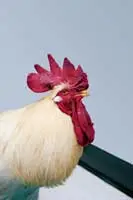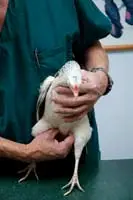Backyard Chickens
Overview
Pet poultry usually have greater sentimental value than poultry in small production operations, and their owners are often more likely to pursue veterinary care when needed.
On presentation, the veterinarian should confirm whether the bird is a pet.
Diagnostic and therapeutic approaches to pets can vary considerably from those for a fryer or laying hen.
Treatment of a production animal focuses on the health of the flock, but the approach to pet poultry should focus on the health of the individual.
Production Poultry
The value of the individual is often limited to its market price per pound.
As a member of the flock, the individual serves as a representative sample—or “biopsy specimen”—of the flock.
On presentation, fecal examination or serologic testing may provide sufficient insight into the flock’s health, although occasionally it may be necessary to euthanize a patient to conduct appropriate diagnostics.
Preventive medicine is aimed at addressing parasitism, appropriate nutrition, and proper hygiene.
Poultry-specific vaccines are available, but their use is limited in backyard operations.
Health issues are often related to deficiency in husbandry.
Companion Chickens
The value of the individual is often sentimental.
The monetary cost for replacement of a specimen is not a limiting factor for treatment.
Many owners claim that their pet chickens are priceless and true companion animals.
The bond or emotional connection between an owner and a pet chicken can be as profound as that with any other more traditional companion animal.

Wellness Examination
The potential for zoonotic disease, such as chlamydiosis and salmonellosis, places a responsibility on the veterinary practitioner to review and consider the impact of the pet on the client, the client’s family, and the general public.
A thorough wellness examination should include all procedures commonly used in small animal medicine to assess the condition of a seemingly healthy patient. Focus should be on the overall body mass, behavior, and general condition of the integument (ie, plumage, skin, nails, beak, comb).
Basic laboratory studies are essential; the health of the chicken cannot be accurately ascertained from physical findings alone.
Observe the patient before a potentially stressful examination to gauge mentation, activity level, and normal/abnormalbehaviors.
Systemically ill birds may appear weak or demonstrate neurologic deficits.
Differentiating between a weak chicken and one with neurologic deficits is important.
Examine the eyes, ears, and throat, and pay particular attention to the pectoral muscles and the abdomen.
Common disorders, such as parasitism, are often represented by decreased pectoral mass or a prominent keel.
Reproductive disorders, such as egg peritonitis, may cause increased abdominal mass.
As part of the patient history, ask about changes in egg characteristics (eg, laying frequency, hardness/softness of shell, number of eggs, dystocia).
These could be signs of reproductive or nutrition disorders.
Examine the integument to disclose a variety of subtle but significant abnormalities.
Ectoparasites are common; paleness of the comb may be suggestive of anemia from parasitism.
Diagnostics
Chickens often hide signs of illness, so the clinicopathologic approach must be thorough.
Ultimately, diagnostics must complement and qualify the findings of the examination.
Common studies include CBC, serum biochemical profile (including measurement of bile acids), fecal examination (flotation and saline preparation), radiology, and screening for zoonotic diseases.
Even when a broad assortment of diagnostics has been conducted, it is still possible for problems to remain undetected.
Common Problems
Trauma
Trauma can typically be categorized as either an attack wound or long bone fracture.
Injuries are managed using standard small animal principles and with similar techniques.
Feather plucking may be indicated before treatment of some wounds.
Note that a chicken’s skin is thinner than that of a dog or a cat.
The pneumatic nature of avian long bones and the tremendous weight-bearing ratio of a chicken’s legs make proper orthopedic technique a priority.
Open fractures, for example, should not be treated with copious flushing because of the communication of the pneumatic bone with the respiratory system.
Individuals from a production flock may occasionally be presented for treatment of traumatic injury, but owners will typically only choose conservative interventions.
Clients will often elect more aggressive treatment for injuries in pet chickens, even when facing a grave prognosis.
Illness
Manifestations of illness often look the same.
Decreased activity, vocalization, and food intake (anorexia), along with sleeping more often, may signal presence of an illness.
Marked weight loss (absence of pectoral mass) and marked abdominal distention are common but may go unnoticed by clients because of the bird’s heavy plumage.

Understanding Zoonotic Disease
Most pet chickens are kept in isolation, so the potential for zoonotic disease is low.
Backyard flocks have a slightly greater risk for harboring zoonotic disease, but occurrence is still rare.
The veterinary practitioner is the primary link between the pet owner and current knowledge of zoonoses, so it is critical that the practitioner be familiar with such threats.
Salmonellosis may be familiar to the general public, but questions about avian influenza, chlamydiosis or chlamydophilosis, parasites, and similar zoonotic issues may need to be addressed in the veterinary clinic.
Ample reference material is essential for veterinarians who include pet poultry as part of their patient load.
Species at a Glance
Basic laboratory studies are essential; the health of a chicken cannot be accurately ascertained from physical findings alone.
Observing the patient initially to gauge mentation, activity level, and normal or abnormal behaviors prior to examination can avert potential stress.
Common disorders (eg, parasitism) are often represented by decreased pectoral mass or a prominent keel.
Paleness of the comb may be suggestive of anemia from parasitism.
The pneumatic nature of avian long bones and the tremendous weight-bearing ratio of a chicken’s legs make proper orthopedic technique a priority.
Marked weight loss, absence of pectoral mass, and marked abdominal distension are common but may go unnoticed by the clients because of the bird’s heavy plumage.
Drug withdrawal times must be monitored if the pet chicken’s eggs are consumed by owners.
See Checklist: Potential Problems Affecting Poultry
A Bit of Boston Chicken
Boston Market was known as Boston Chicken until 1995. This trivial piece of fast-food pop culture took on a new meaning for me last winter. We had multiple major snowstorms in the greater Boston area last year. During one of them, I was collapsed on the couch, dozing, when the telephone rang. It was my friend, panicked, telling me that her chicken, Dusty, was sick.
“Sick? Chicken? You have a chicken?” I was both unable to process this information and had no idea what to do with it!
I plodded over to her house in the driving snow—gigantic boots and all.
Dusty wasn’t eating and had diarrhea, my friend explained. She then told me that since I was a vet I should know what to do. So, I looked at the pullet. I petted her comb and palpated her crop. I listened to her heart. She had magnificent russet feathers and adorable little eyes. She looked fine to me. I was completely clueless.
I spent the rest of the evening glued to references and resources trying to provide chicken therapy for my friend. I had no idea what I was doing until I made the right move: I decided to leave the Boston Chicken to an expert by referring Dusty to an avian veterinarian.
Dusty is now thriving after treatment for coccidiosis, and I was reminded of how valuable ongoing learning can be—even during a raging snowstorm.
Indu Mani, Editor
DON J. HARRIS, DVM, speaks at numerous national and international veterinary conferences and has received the Outstanding Service Award from the Association of Avian Veterinarians and the Speaker of the Year Award from the NAVC, among other conferences. He has served as president of the South Florida Veterinary Medical Association and of the Association of Avian Veterinarians and is past president of the NAVC. After several years of practicing mixed-animal medicine, his practice became exclusively avian in 1990 and in 1996 he opened Avian and Exotic Animal Medical Center, Miami’s first exotics-only veterinary hospital. Dr. Harris is a graduate of Louisiana State University School of Veterinary Medicine.